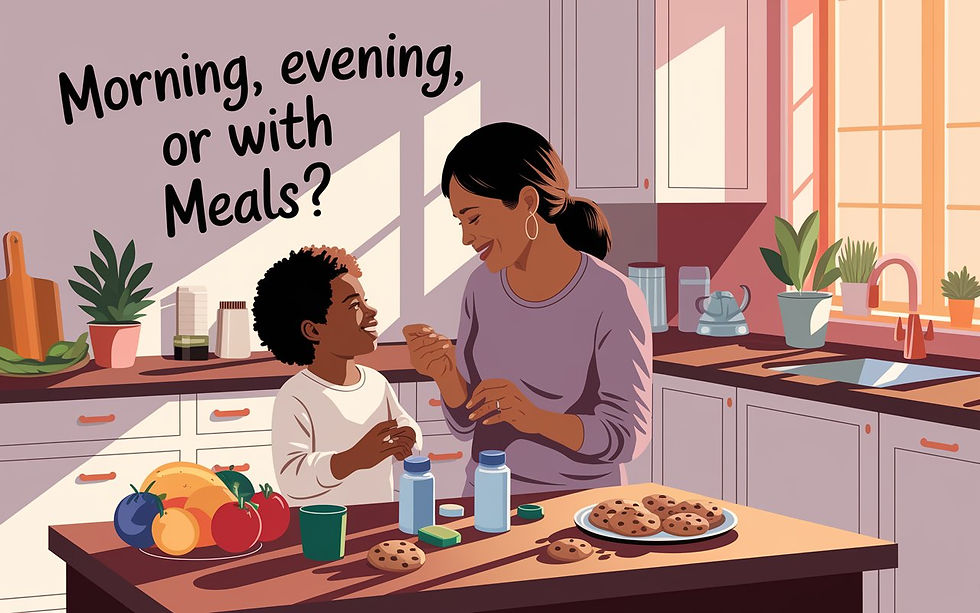The Best Time to Give Vitamins for Kids: Morning, Evening, or With Meals?
- gumazing2
- Jun 27
- 4 min read
When it comes to vitamins for kids, parents often focus on the what—but the when can be just as important. Whether you’re using chewables, gummies, or drops, knowing the best time of day to give vitamins can help improve absorption, prevent tummy troubles, and ensure consistency in your child’s health routine.
Let’s explore how timing impacts each type of supplement and when to give them for the most benefit.

Morning vs. Evening: Which Is Better?
The short answer? It depends on the vitamin.
Morning
Giving vitamins in the morning works well because:
It aligns with breakfast, making it easy to remember
Certain vitamins (like B vitamins) can support daytime energy and focus
It builds a habit early in the day
However, for kids with sensitive tummies, vitamins on an empty stomach might cause nausea.
Evening
Some parents find giving vitamins at night more convenient. While fat-soluble vitamins like A, D, E, and K are not affected by the time of day, some energizing vitamins (like B12) might disrupt sleep if taken too late.
For this reason, most pediatricians recommend morning or with-meal dosing for vitamins for kids.
Best Practices: Pair with Meals
The safest and most effective time to give your child vitamins is with food. Here’s why:
Fat-soluble vitamins absorb better when paired with healthy fats
It reduces the chance of stomach upset
It becomes part of a meal routine, making it harder to forget
Example: Pairing vitamin d and calcium supplements with a breakfast that includes eggs, avocado, or nut butter can significantly enhance absorption.
When to Give Specific Types of Vitamins
Let’s break down ideal timing by supplement type:
1. Multivitamin Gummies
These are best given with breakfast or lunch, when your child is alert and active. Avoid right before bed, as they may contain B vitamins that stimulate the nervous system.
Pair multivitamin gummies with vitamin d and calcium supplements in the morning meal to support overall development, energy, and bone health.
2. Vitamin D Drops for Kids
Vitamin D is best absorbed with fat-containing foods. So, give vitamin d drops for kids during a meal with healthy fats.
If your child doesn’t eat high-fat foods in the morning, consider moving this dose to lunch or dinner. Consistency matters more than time of day.
3. Probiotics for Gut Health
Unlike traditional vitamins, probiotics for gut health may work best either 30 minutes before meals or with food, depending on the strain. Many newer formulations are designed to survive stomach acid and don’t require special timing.
Stick to what your specific brand recommends, but for kids, breakfast is usually the most practical time.
4. Eye Care Gummies for Kids
These usually contain lutein, zeaxanthin, and vitamin A—all fat-soluble nutrients. For best results, give eye care gummies for kids alongside meals that include healthy fats like dairy, nuts, or eggs.
They can be paired safely with multivitamin gummies during the same meal, as long as you’re not exceeding daily intake values.
Creating a Child-Friendly Supplement Routine
Here are simple ways to make vitamin time easier and more consistent:
Link it to daily habits: Breakfast, brushing teeth, or school prep
Use a visual calendar: Let kids mark off their vitamin day
Choose tasty formats: Gummies, powders in smoothies, or flavored drops
Keep everything together: A supplement caddy by the breakfast table works wonders
Just remember—consistency is more important than perfect timing.
How to Avoid Nausea or Side Effects
Some kids experience mild nausea when taking vitamins, especially iron or B-complex. To avoid this:
Never give on an empty stomach
Use chewables or gummies instead of tablets if your child is sensitive
Reduce the dose or switch to every other day under pediatric guidance
If you notice ongoing discomfort after vitamin d drops for kids, talk to your pediatrician. You may need to change the dose or switch to a different form.
Final Thoughts: Find What Works for Your Child
While the best time to give vitamins for kids can vary slightly by type, the key is finding a routine that works for your child and sticking with it. Morning with breakfast is ideal for most, especially when combined with food for better absorption and fewer side effects.
Support their routine with additional nutrients from vitamin d and calcium supplements, multivitamin gummies, vitamin d drops for kids, and probiotics for gut health—all thoughtfully spaced for maximum benefit.
FAQ: Vitamin Timing for Kids
Q1: Can I give all vitamins at once?
Yes, most kids’ supplements are formulated to be taken together. Still, check the label and talk to your pediatrician for specific combinations.
Q2: What if my child skips breakfast?
Give vitamins with the next meal that contains fat (like lunch or dinner). The key is to avoid an empty stomach.
Q3: Can vitamins affect sleep?
Yes, especially B vitamins and some energy-boosting blends. If sleep becomes an issue, shift vitamins to earlier in the day.
Q4: What happens if I miss a day? No problem—just continue the next day. Nutritional balance is built over time, not in one dose.
Q5: Should I give probiotics before or after food? Most child probiotics work well with food. But some strains are more effective before meals—check your product's label.



Comments